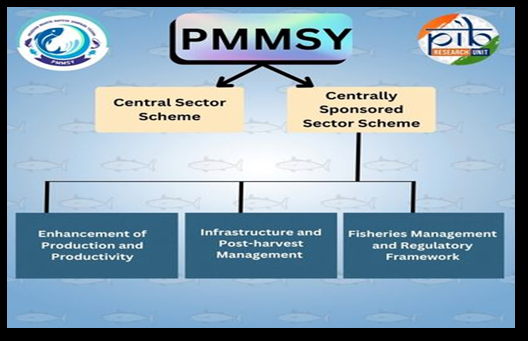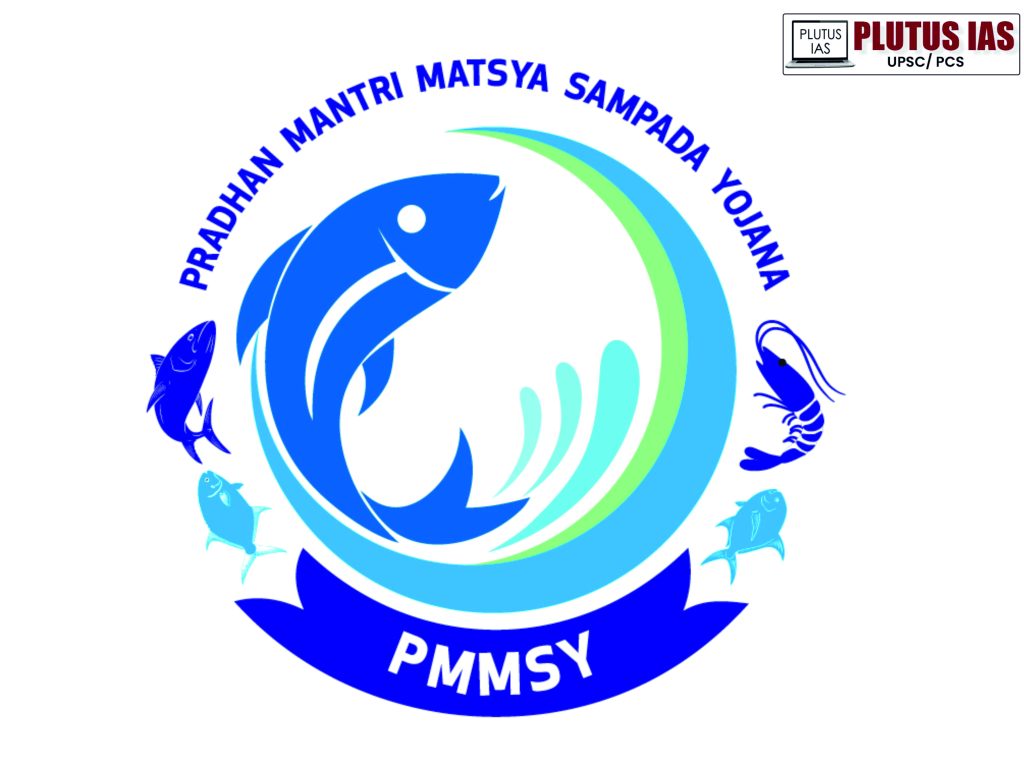Punjab produces over 1.81 lakh tons of fish annually from natural waters, private, and Panchayati ponds, with more than 43,900 acres dedicated to fish farming in the state. The State Fisheries Department has disbursed more than 30 crore rupees in subsidies to 618 families over the past four years under the centrally sponsored Pradhan Mantri Matsya Sampada Yojana to promote the Blue Revolution. During a seminar organized by the department to educate fish farmers about new technologies, best practices, and innovative methods of fish farming, State Minister of Animal Husbandry, Dairy Development, and Fisheries Gurmeet Singh Khudian highlighted that approximately 14 crore quality fish seed is produced annually at 16 government fish seed farms and distributed to farmers at subsidized rates. Additionally, Punjab is making progress in shrimp farming by utilizing thousands of acres of land that were previously unsuitable for agriculture due to waterlogging and salinity.
What is PM -MSY?
The Pradhan Mantri Matsya Sampada Yojana (PMMSY) is a flagship initiative launched by the Government of India to promote sustainable fisheries and aquaculture development in the country. It was launched in 2020 under the Ministry of Fisheries, Animal Husbandry, and Dairying, with the goal of boosting the fisheries sector and improving the livelihoods of fishers, fish farmers, and workers.
Key Objectives of PMMSY:
1. Infrastructure Development: It focuses on developing modern infrastructure for fisheries, such as fish landing centres, cold storage facilities, and processing units.
2. Post-Harvest Management: The scheme aims to improve the value chain from harvesting to processing and marketing, including cold chain facilities, which ensure better quality and reduced wastage.
3. Technological Advancement: Encourages the use of modern and sustainable technologies in fishing, aquaculture, and post-harvest management.
4. Fishermen Welfare: The scheme is designed to uplift the living standards of fishermen and fish farmers by providing them with necessary support, training, and subsidies.
5. Sustainability: Focuses on environmentally sustainable practices and supports the development of climate-resilient coastal villages.
Fishery sector in India
| Category |
Data |
| Total Fish Production |
Over 13 million metric tons annually (including inland and marine) |
| Marine Fish Production |
3.8 million metric tons (approx.) |
| Inland Fish Production |
9.4 million metric tons (approx.) |
| Fish Export Value |
USD 8.5 billion (approx.) in 2021 |
| Top Fish Exporting States |
West Bengal, Andhra Pradesh, Kerala, Tamil Nadu, Gujarat |
| Total Area under Aquaculture |
2.4 million hectares (approx.) |
| Fish Farming Area (Ponds and Tanks) |
1.4 million hectares (approx.) |
| Number of Fishers/Fish Farmers |
14 million people engaged in fishing and aquaculture |
| Aquaculture Production Growth Rate |
7-8% per year |
| Contribution to GDP |
Approx. 1.1% of the Indian GDP from the fisheries sector |
| Fish Consumption per Capita |
10.2 kg per capita per year (approx.) |
| Fish Seed Production |
Over 50 billion seeds annually (for aquaculture) |
| Marine Fish Export Share |
Over 70% of India’s fish exports are marine products |
| Top Fish Species Farmed |
Carps, Catla, Rohu, Tilapia, Pangasius, Shrimp (Vannamei) |
| Fisheries’ Share in Agriculture GDP |
Approx. 5.23% (of the total agriculture GDP) |
| Fisheries Infrastructure Investment |
Rs 20,050 crore (PMMSY investment over 5 years, 2020-2025) |
| Number of Fishing Harbors |
150+ fishing harbours across India |
| Fisheries Startups |
100+ start-ups promoted under PMMSY |
| Total Coastal Area |
7,500 km of coastline, contributing significantly to marine fisheries |
Objectives and components of PM-MSY
1. Increase Fish Production: Boost both marine and inland fish production to ensure a steady supply of nutritious food and enhance food security.
2. Sustainability and Growth: Promote environmentally sustainable fishing practices, minimize over-exploitation of marine resources, and develop aquaculture in a sustainable manner.
3. Infrastructure Development: Build and upgrade infrastructure like fish landing centers, cold storage, and processing units to support the value chain.
4. Technological Innovation: Encourage the use of modern technologies in fishing, fish farming, and post-harvest management to improve efficiency and reduce wastage.
5. Fishermen Welfare: Improve the livelihoods of fishers, fish farmers, and workers by providing financial support, training, and access to credit and insurance.
6. Value Chain Enhancement: Strengthen the entire fisheries value chain from production, processing, and marketing to enhance economic benefits.
7. Climate Resilience: Develop climate-resilient fishing practices and support coastal villages in adapting to climate change challenges.
8. Formalization of the Sector: Organize and formalize the fisheries sector, especially for small-scale fisheries, cooperatives, and entrepreneurs.
Components of PMMSY
PMMSY has two major components:
1. Central Sector Scheme (CS): Fully funded and implemented by the central government. Focuses on the development of infrastructure, technology, and capacity building.
2. Centrally Sponsored Scheme (CSS): Partially funded by the central government, with the balance funding provided by the state governments. Implemented by state governments and their agencies.

What is an issue in India’s fishery sector?
1. Overfishing and unsustainable practices: Depletion of marine fish stocks due to overfishing and illegal fishing methods.
2. Climate change: Rising ocean temperatures, acidification, and extreme weather events impacting fish habitats and breeding.
3. Poor infrastructure: Lack of modern fish landing centres, cold storage, and transport facilities leading to post-harvest losses.
4. Water pollution: Industrial discharge, agricultural runoff, and plastic pollution degrade water quality and harm fish.
5. Outdated aquaculture: Limited access to modern technologies, quality seeds, and efficient farming methods in rural areas.
6. Limited research: Insufficient research on sustainable practices, breeding techniques, and fish health management.
7. Financial constraints: Inadequate access to credit, insurance, and financial literacy for small-scale fishers.
8. Livelihood issues: Low income, poor living conditions, gender inequality, and youth migration from fishing communities.
Way to make the fishery sector more productive, efficient and sustainable
1. Promote Sustainable Fishing Practices: Implement and enforce sustainable fishing regulations, including setting fishing quotas, restricting illegal fishing, and using eco-friendly gear to prevent overfishing and protect marine ecosystems.
2. Modernize Aquaculture Practices: Invest in modern aquaculture technologies such as recirculating aquaculture systems (RAS), better breeding techniques, and efficient feed management to increase production and reduce environmental impact.
3. Improve Infrastructure: Develop and upgrade cold storage, fish landing centers, and processing facilities to reduce post-harvest losses, improve the shelf life of fish, and facilitate efficient supply chains.
4. Enhance Water Quality Management: Implement better management of water bodies and control pollution through improved waste disposal, agricultural runoff management, and water treatment systems for aquaculture farms.
5. Adopt Climate-Resilient Practices: Develop climate-resilient aquaculture and fisheries practices, including using saline or brackish water for aquaculture and improving disaster preparedness in coastal and fishing communities.
6. Increase Research and Development: Focus on R&D for breeding better fish species, improving disease management, and creating innovative farming techniques to boost productivity while reducing environmental degradation.
7. Strengthen Financial Access: Provide better access to credit, insurance, and subsidies for fishers and farmers, particularly small-scale producers, to improve their financial stability and enable investment in modern technologies.
8. Capacity Building and Skill Development: Organize training programs to enhance the skills of fishers, farmers, and stakeholders in adopting best practices, new technologies, and sustainable farming methods to improve efficiency and profitability.
Conclusion






No Comments